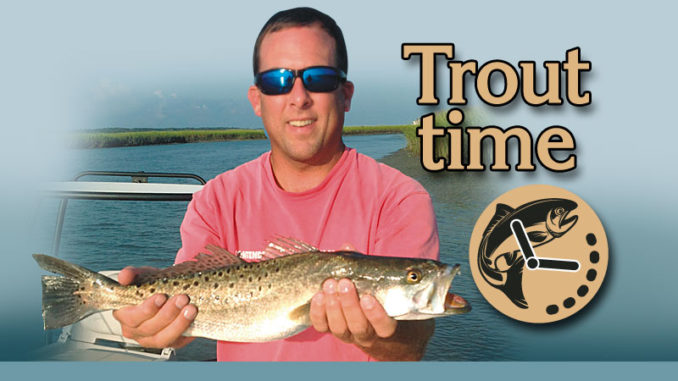
Specks will bite aggressively this month
The cork bobbed a little as it approached an oyster rock where trout had gathered to feed on shrimp and minnows washing down the creek behind Ocean Isle Beach. That got Brandon Sauls’ attention. Suddenly, the shrimp that was hooked up under the cork was at the surface and jumping frantically, giving its all to escape from a predator.
All of a sudden, there was a swirl, and the shrimp and cork both disappeared. It wasn’t a cautious take, either; the cork was unceremoniously jerked under by something that wanted the shrimp. Sauls leaned back into a sweeping hookset, and the light spinning rod bowed double, with line ripping from the small reel. The fish struggled hard and made multiple runs while starting and stopping and rolling.
The fishermen weren’t sure whether the fish was a speckled trout or a redfish until it was finally led to the surface and flashed a side of small spots as it was led into a waiting landing net. But it was the fish’s lucky day; after a quick picture, Sauls eased it back into the water.
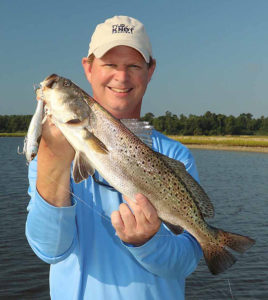
Sauls and his fishing buddy, guide Mark Stacy, repeated this scenario multiple times that morning and left the trout biting when they ran out of fishing time.
“It isn’t always like this, but our trout fishing can be very good at times,” said Sauls, a former guide who runs an internet design and consulting company and now fishes just for fun. “We’ve got a diversity of habitat in just a few miles and usually can find somewhere the trout are biting. Our weather is also a plus for good fall fishing. There may be some cold fronts that cool the water and get the trout going, but many days in November are shorts and T-shirt weather, especially in the afternoons.”
Ocean Isle Beach is in Brunswick County, which begins at the Shallotte River and runs south and west to the North Carolina-South Carolina border. The diversity includes the Intracoastal Waterway, Shallotte River, Calabash Creek, a bit of other open water, a medium-use inlet, a very small inlet, a variety of creeks, concrete-bottom canals, oyster rocks, riprap, holes and, about 100 yards across the state line, a jettied inlet. Sauls suggests that anyone fishing this area have both licenses from both states so they can move about as they like.
Sauls said trout fishing using live shrimp under corks is very productive and popular with many fishermen. He rigs them using a pole float so a wary trout only feels minimal resistance when taking the bait. His rig is a bobber-stopper setup, where the bobber stopper can be moved to adjust the depth of the bait below the float. There is a 1/2-ounce egg sinker below the float to hold the bait down and a 15- to 18-inch piece of fluorocarbon leader out to a No. 6 treble hook that is pinned just under the horn on the shrimp’s head. Sauls said for best results, cast a little upcurrent from where you expect the trout have gathered, and allow the current to carry it into the strike zone. If it has settled and looks natural, one will pick it up.
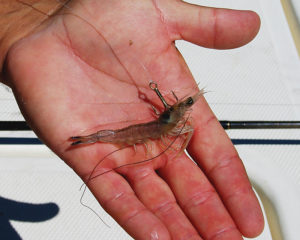
Sauls said as well as the live shrimp rig works, they aren’t always available, and there are other ways to catch specks that are more fun. He said artificial Vudu Shrimp are a surprisingly good substitute for live shrimp. They have segmented tails so their tails move freely in the current and with any twitch of the line.
Sauls’ favorite way to catch specks is using topwater lures, and the waters in and around Brunswick County stay warm enough for this well into November, sometimes into December. Once the areas of open water cool to 60 degrees and below, he concentrates on marsh creeks and pockets where the water doesn’t full drain on low tide and stays a couple of degrees warmer. The trout are more active and feed more consistently in the warmer water.
Sauls’ two favorite topwater lures are Top Dogs and Super Spook Jrs. They are slightly different in shape — the Top Dog is larger — but Sauls believes the big difference is in their sound. He said the Top Dog has a single, lower-frequency rattle, while the Super Spook Jr. has multiple, higher-frequency rattles. If the trout are feeding at or near the surface, one of them will usually draw strikes.
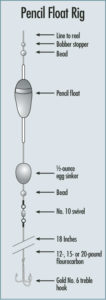 Moving water is a key, and matching the lure’s movement and speed to the bait in the area is another. Sauls said baitfish are typically moving along the sides of the creeks or bays, and trout set up ambush at oyster rocks, points, creek mouths and other areas where there is a drop into deeper water. They hold in the deeper water and rush up to attack bait moving by in the shallows. Working the lure at the proper speed helps entice strikes and put fish in the cooler.
Moving water is a key, and matching the lure’s movement and speed to the bait in the area is another. Sauls said baitfish are typically moving along the sides of the creeks or bays, and trout set up ambush at oyster rocks, points, creek mouths and other areas where there is a drop into deeper water. They hold in the deeper water and rush up to attack bait moving by in the shallows. Working the lure at the proper speed helps entice strikes and put fish in the cooler.
The late Mark Dickson was a pioneer inshore guide in this area, and he worked sinking/diving lures in addition to those Sauls mentioned. Dickson believed that on bright, sunny days — and once the water temperature dropped below 60 degrees — trout moved to the deeper holes. He had a few holes near riprap or off oyster rocks where it took a deeper-running lure to get down to them.
Dickson liked to fish MirrOlures in 52M, 52MR, TT and TTR series. These are all sinking lures, and the 52MR in a lure with higher-frequency rattles. Dickson liked to cast them slightly up and across the current, letting them sink and move with the current. He would twitch them occasionally to mimic baitfish, and as the water got colder, he concentrated on fishing these when the tide was slowing to change and just after a tide change. He believed keeping them in front of the trout longer helped tempt the trout into biting. He also believed in scented lures and was convince that, in colder water, you had to move your bait slowly, even to the point of dead-sticking it, letting the scent convince lethargic trout to bite.
Speckled trout
Spotted seatrout, Cynoscion nebulosus, aka speckled trout, are members of the Sciaenidae family, which includes drums, croakers and gray trout (weakfish). They are prized gamefish that range from the Laguna Madre in south Texas to the upper reaches of the Chesapeake Bay, with catches reported as far north as New York.
Speckled trout can tolerate extreme variations in salinity; in North Carolina, excellent catches are often reported in waters designated as inland waters. As long as the water quality is tolerable and there is a good food supply, speckled trout don’t pay much attention to where they are.
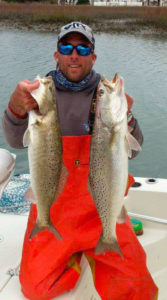
While the fall is when North Carolina fishermen heartily pursue speckled trout, they may be found in many locations all winter, which exposes them to cold-stun and kill events. Several times in recent years, kills have been severe enough to have the recreational season closed until June 15.
Their tendency to be caught in cold stuns and kills makes North Carolina speckled trout very cyclic. But they are prolific spawners, and most reach reproductive age in their first year. All trout that meet the 14-inch minimum size have likely spawned several times
Speckled trout are batch spawners that usually begin spawning in mid- to late April and continue spawning every week or so through October. They grow quickly, and many will reach 14 inches in the late fall of their first year.
Fishermen should take a few seconds to look for tags on speckled trout they catch. A study done several years ago offers rewards up to $100 for returned tags. Biologists with the N.C. Division of Marine Fisheries are asking fishermen to return all tags. The gathered information will help fishery managers better understand the growth, movement and spawning habits of the fish.
DESTINATION INFORMATION
HOW TO GET THERE — US 17 is the primary access route to the marshes of Brunswick County between Shallotte and the North Carolina-South Carolina border. NC 130, NC 179 and NC 904 cross US 17 and lead to Sunset Beach, Ocean Isle Beach and Calabash. Public boat-access areas are on the ICW at Brick Landing on the mainland near Shallotte Point, beside the Ocean Isle Beach bridge on the beach side and beside the Sunset Beach Bridge on the mainland side.
WHEN TO GO — The best action typically begins in October, peaks in November and continues into December. Speckled trout are a highly sought-after fish in this area, and their popularity rose a few more points when flounder season closed in September.
BEST TECHNIQUES — Live shrimp fished under corks is the preferred bait for many fishermen. If shrimp aren’t available, live mullet minnows and mud minnows are acceptable. As far as artificial lures, soft-plastic shrimp imitations such as Vudu and Gulp! lead the class. Topwater baits and diving/sinking baits can also be very productive in the right situations. Most fishermen find light and medium-light spinning outfits in 7-foot lengths to be plenty for specks and the occasional redfish. Use 8- to 15-pound braid with 12 to 24 inches of fluorocarbon leader.
FISHING INFO/GUIDES — Mark Stacy, Ocean Isle Fishing Charters, 910-279-0119, www.oceanislefishingcharters.com; Kyle Hughes, Speculator Inshore Fishing Charters, 910-840-7186, www.oceanislefishingguide.com; Ocean Isle Fishing Center, 910-575-3474, www.oifc.com; Anglers Marine, 910-755-7900, www.anglersmarinenc.com; Jimmy’s Marine, 910-575-3600, www.jimmysmarine.com. See also Guides & Charters in Classifieds.
ACCOMMODATIONS — Ocean Isle Inn, Ocean Isle Beach, 910-579-0750, www.oceanisleinn.com; Winds Resort Beach Club, Ocean Isle Beach, 910-579-6275, www.thewinds.com; Comfort Inn, Shallotte, 910-754-3044; Days Inn, Shallotte, 910-754-3300; Econo Lodge, Shallotte, 910-755-6444; Brunswick County Chamber of Commerce, 800-426-6644, www.brunswickcountychamber.org.
MAPS — Capt. Segull’s Nautical Charts, 888-473-4855, www.captainsegullcharts.com; Sealake Fishing Guides, 800-411-0185, www.thegoodspots.com; GMCO Waterproof Chartbook of North Carolina, 888-420-6277, www.gmcomaps.com.





Be the first to comment